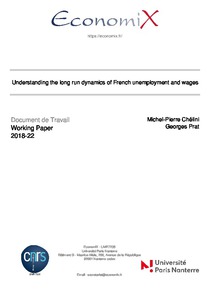Understanding the long run dynamics of French unemployment and wages
"A standard specification of the WS-PS model based on wage bargaining between unions and firms makes it possible to understand the main features of long-term dynamics of unemployment and wages in France at the macroeconomic level. This result is conditional on auxiliary hypotheses made on the r...
| Main Authors: | , |
|---|---|
| Institution: | ETUI-European Trade Union Institute |
| Format: | TEXT |
| Language: | English |
| Published: |
Nanterre
2018
Université Paris Ouest Nanterre La Défense |
| Subjects: | |
| Online Access: | https://www.labourline.org/KENTIKA-19399127124911173099-understanding-the-long-run-dyn.htm |
| Summary: | "A standard specification of the WS-PS model based on wage bargaining between unions and firms makes it possible to understand the main features of long-term dynamics of unemployment and wages in France at the macroeconomic level. This result is conditional on auxiliary hypotheses made on the representations of the degree of rigidity in the labour market (depicted by a stochastic state variable), of the reservation wage (depending on the legal minimum wage), and on the nature of “other factors” pertaining to wages and prices that are not a priori specified in the WS-PS theoretical framework (summarized by the output gap). We find that the observed unemployment adjusts gradually to its equilibrium value, which is composed of three components: a “chronic” component due to the repartition in the added-value (real reservation wage, social contributions, productivity, profit margins of companies), a “cyclical” component depending on the output gap, and a “frictional” component due to the imperfect mobility of labour and technical progress. The observed wage also adjusts gradually to its negotiated value, the latter depending on the reservation wage, the social contributions, the price level, the labor productivity, the profit margins of companies, the unionization rate and on the unemployment rate whose influence is time-varying. Our results suggest that, in the average, the power of firms dominates that of unions during the negotiations, while, as predicted by the theory, change in employment intervenes effectively in the adjustment between wage desired by employees and wage offered by employers to achieve equilibrium." |
|---|---|
| Physical Description: | 36 p. Digital |

